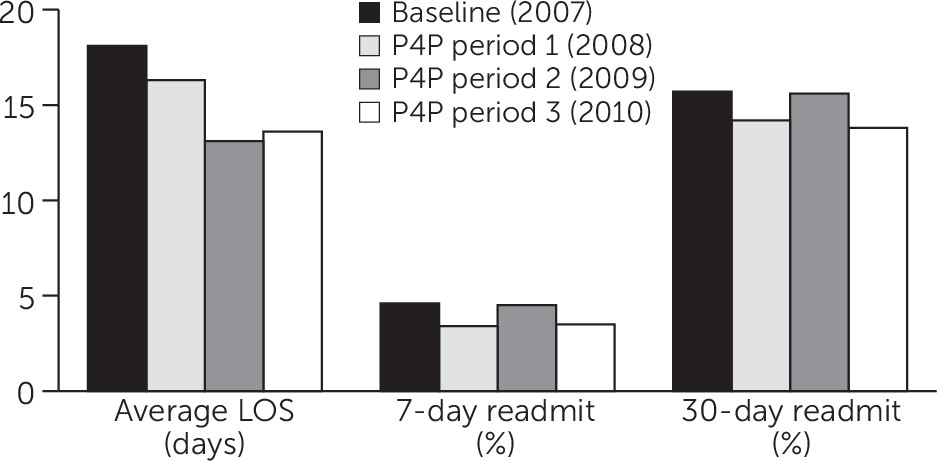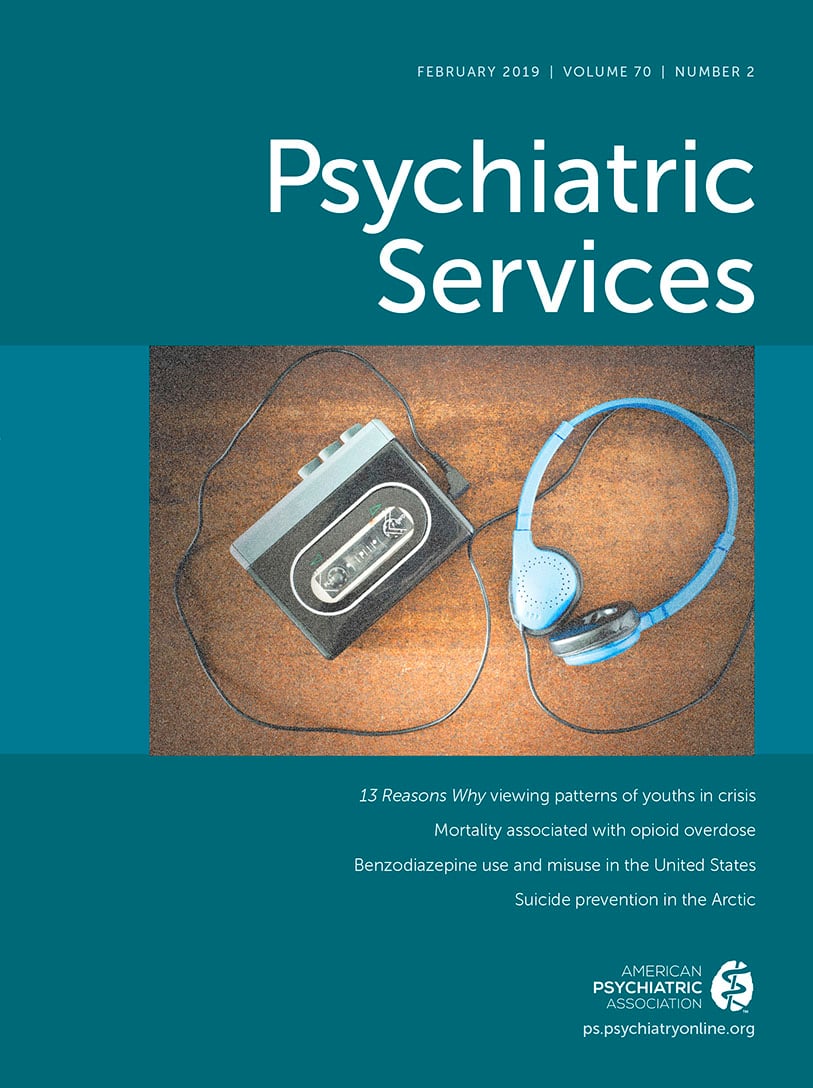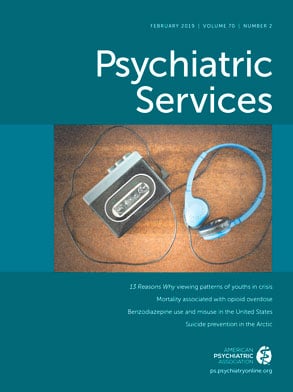Recent national trends show significant increases in pediatric inpatient hospitalization and emergency department (ED) visits for mental health conditions (
1). Child mental health has been identified in federal health policies as a key area for quality improvement, with inpatient care targeted as a high priority for quality measurement (
2,
3). Previous studies on pediatric inpatient use offer mixed results regarding the impact of length of stay (LOS), diagnosis, and aftercare on clinical outcomes (
4–
8). One strategy to improve health care, in general, has been the incorporation of pay-for-performance (P4P) programs, which offer incentives to providers according to selected criteria to improve quality patient outcomes. A 2017 review of 15 studies suggested that P4P in behavioral health care can achieve desirable effects in treatment access, continuity, fidelity, and engagement (
9).
This column describes the efforts by Connecticut’s Behavioral Health Partnership (CT BHP) to expedite system change through a P4P program focusing on reducing pediatric inpatient LOS. Secondary outcome improvements included increased postdischarge use of medically necessary community-based services as well as decreased rates of inpatient readmission. The CT BHP is an interdepartment partnership between the Department of Children and Families (DCF), Department of Social Services (DSS), and Department of Mental and Addiction Services to create an integrated public behavioral health service system for children, adults, and families with Medicaid and for children and youths in the DCF Voluntary Services Program. The administrative service organization for the CT BHP, Beacon Health Options, manages behavioral health care for more than 800,000 Medicaid members through coordinating clinical management processes across the system of care. Data for this retrospective cohort study are provided for the three consecutive years the P4P program was funded. In addition to average inpatient LOS, 30-day readmission rates and 180-day postdischarge community-based service use during the P4P period were compared with baseline for the youths discharged from the participating hospitals.
Beginning in 2008, the CT BHP collaborated with all acute care hospitals with pediatric inpatient units to initiate an incentive program to decrease inpatient LOS while reducing readmissions and discharging to clinically appropriate community-based services. Individual performance for the eight participating hospitals was measured for three periods from 2008 through 2010 with retroactive payments issued based on the results of each hospital’s performance. For period 1 (July 1 to December 31, 2008), the P4P quality improvement goal was reducing the average LOS compared with the prior year. For period 2 (January 1 through December 31, 2009) and period 3 (January 1 through December 31, 2010), the quality improvement goal was changed to meeting or exceeding goals for reduced LOS (rather than merely progressing toward shorter LOS), as well as implementing revised procedures to improve family involvement in treatment and discharge planning.
During the P4P initiative, participating hospitals were scored based on their demonstrated ability to reduce LOS (or maintain already efficient lengths of stay) and to enhance family engagement. Based on their accomplishment in respect to these goals, hospitals were awarded a share of a performance fund. Performance LOS goals for each hospital were case-mix adjusted to account for the proportion of pediatric inpatients who historically have been shown to be more difficult to treat and discharge appropriately back to the community. The four case-mix categories were based on a 2×2 matrix based on age (≤12 years versus 13–18 years) and DCF involvement (yes versus no). Performance goals were based on adjusted averages for LOS from the previous year and involved the removal of the longest LOSs (top 4%) from each of the four categories for each participating hospital.
Claims and authorization data came from the DSS and Beacon Health Options, the administrative service organization for CT BHP. Outcome data for this project focused on inpatient LOS, readmission rates (7 day and 30 day), and the use of postdischarge community-based behavioral health. Only beneficiaries with continuous enrollment for 180 days postdischarge were included in the study so that patterns of ongoing care following discharge could be examined. This evaluation was conducted as a quality improvement initiative under the authority of a contract with the state Medicaid authority.
Outcomes
All hospitalized youths at the eight P4P hospitals were identified by using Beacon authorization data matched with DSS claims data to obtain all community-based behavioral health care service information. In the year prior to the P4P program, there were 2,237 inpatient admissions for 1,506 members. For P4P periods 1, 2, and 3, the number of inpatient stays were 882 (715 members), 1,975 (1,408 members), and 951 (782 members), respectively.
The average LOS decreased significantly from baseline, by 25%, by the final year of the P4P program (
Figure 1). Moreover, there were no significant changes in 7- or 30-day readmission rates over the course of the P4P program.
With respect to timely postdischarge care, the first service for most members was outpatient care from either a behavioral health provider or medical practitioner. For those who were readmitted within 30 days, 69% (N=555) saw an outpatient provider within an average of four days of leaving the hospital. Although 75% (N=3,934) of those who were not readmitted within 30 days also received timely outpatient aftercare, the average number of days from discharge was notably longer (19 days for behavioral health appointments, 20 days for medical visits). Six percent (N=48) of youths who were readmitted within 30 days went directly into residential treatment compared with 13% (N=682) of those who were not readmitted. Of those who were readmitted to the hospital within 30 days, 67% (N=537) had DCF involvement compared with 52% (N=2,728) of members who remained out of the hospital.
Whereas case management and home care services were not used by any members as a first service after leaving the hospital, case management services were received by the 30-day readmitted cohort and the non-readmitted cohort at similar rates during the first 180 days postdischarge (4.0% and 3.6%, respectively). Disproportionately more youths who were readmitted within 30 days received services from outpatient medical providers (5.6% versus 0.6%).
Notable differences were observed in the estimated cost per member for 180-day postdischarge services (i.e., inpatient, ED, case management, outpatient medical and behavioral, and residential care). For members who were rehospitalized within 30 days, the average cost was $98,787 compared with $25,136 for youths who were not readmitted within 30 days, with 83% of the greater cost due to repeated hospitalization. Six-month postdischarge services costs for DCF-involved youths ($76,174) were higher than those for non-DCF youths ($10,768) due to higher use of all community-based services.
With respect to service use during the first 180 days postdischarge, the cohort who was readmitted within 30 days received a higher average number of services compared with non-readmitted youths (29.5 versus 26.5). DCF-involved youths received a higher average number of paid units for case management or home care services compared with non-DCF-involved youths (16.3 versus 2.23) and outpatient behavioral health services (136.3 versus 14.8).
Discussion
The results of this P4P initiative to reduce psychiatric inpatient hospitalizations for children and adolescents at eight hospitals in Connecticut demonstrate that reductions in the average LOS are achievable without apparent deleterious outcomes. From 2008 to 2010, when hospitals received financial incentives for performance improvements, the average duration that youths spent on psychiatric inpatient units was reduced from 18.1 to 13.6 days. During the same period, the 7- and 30-day readmission rates remained stable with nonsignificant decreases.
For youths who were readmitted within 30 days, there are no indications that barriers to accessing timely aftercare were a factor. Compared with youths who were not rehospitalized within 30 days, the readmitted cohort received outpatient follow-up care significantly sooner after discharge (3.3 days for readmitted versus 20.5 days for non-readmitted) and received more services overall in the 180 days after leaving the hospital.
Although these findings suggest that the P4P was effective in reducing average LOS, caution is warranted in concluding that these changes resulted solely from the P4P initiative. Although consistent with the scope of other P4P evaluations (
9), this uncontrolled, pre–post design did not account for other initiatives that were concurrently implemented and may have affected outcomes, including expanded emergency mobile psychiatric services for youths and increased rates for child-focused behavioral health outpatient clinics that agreed to provide access to services within specific shorter timeframes. The descriptive nature and lack of information about other clinically pertinent information (e.g., diagnoses, medications, and parental involvement) prevented more advanced statistical modeling of service use patterns and outcomes.
The process used to develop and the timing of the initiative may also have affected the results. The P4P methodology and goals were developed collaboratively with the participating hospitals and DCF during a time when youths were frequently delayed for several days in the ED waiting for a pediatric behavioral health inpatient bed. The ED delays were a burden to the hospitals, because they are not equipped to care for psychiatric patients for prolonged periods in an ED setting. Inpatient stays were also often protracted, particularly for youths with DCF involvement, because DCF delayed making necessary decisions about placement after discharge. Those delays, beyond the immediate control of the hospital, extended the LOS of youths ready to leave the hospital. Enhanced assistance in discharge planning to hospital staff by Beacon intensive case managers, including on-site participation in clinical rounds, coupled with quarterly regional and statewide meetings between the hospitals and DCF, was also included in the initiative to address barriers to timely discharge.
This column appears to be the first published evaluation of a P4P initiative focused on pediatric mental health services. Moreover, most of the extant literature on P4P in behavioral health is focused on adult substance use (
9). Additional research is needed to explore patient, hospital, and regional service environment characteristics that may influence health care processes and outcomes to identify metrics of quality for pediatric mental health treatment across the continuum of care.
These results suggest that P4P initiatives can facilitate necessary change in systems of care providing pediatric mental health services. In addition to changes in care practices at each of the hospitals, equally important were changes between the hospitals and with DCF, including improved collaboration and communication between all organizations. Although complete service use data are not available, the CT BHP continues to monitor the average LOS at the hospitals that participated in the P4P program. The P4P initiative was discontinued due to economic constraints associated with recovering from the Great Recession of 2008; however, data reveal that shortened LOS has persisted with linear annual reductions through 2016 (
10). We believe much of the success is attributable to continuation of the activities that evolved during the initiative. For the example, the CT BHP continues to meet quarterly with each hospital to review data on LOS, readmission, and postdischarge care. Additionally, the quarterly and semiannual meetings have continued, during which hospitals and DCF share continuous quality improvement efforts and discuss solutions to barriers. Dedicated DCF staff have also been assigned to each hospital. In brief, activities that promoted a sense of unity between the involved organizations during the P4P have persisted. These outcomes suggest that a period of incentivized quality improvement efforts can spur positive and enduring changes in the provision of acute behavioral health services for youths that affect the entire system of care.


